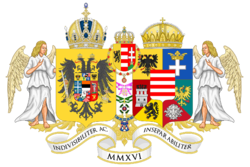Karno-Ruthenian Compromise of 2016
| Karno-Ruthenian Compromise | |
 Coat of Arms of the Karno-Ruthenian Empire.
| |
| Created | 10 March 2016 |
| Location | Persenburg, Kingdom of Ruthenia |
| Authors | Emperor-King Oscar of Karnia-Ruthenia, Archduke Anton of Karnia and Prince Weslley of Agram |
| Signers | |
| Purpose | Establish the dual monarchy of Karnia-Ruthenia and unite the Kingdom of Horvatia to the Empire. |
The Karno-Ruthenian Compromise of 2016 is a treaty signed between the government of the Kingdom of Ruthenia and of the government of the Empire of Karnia in which it was agreed to establish a constitutional monarchy where the regions of the micronation would be governed by separate parliaments and prime ministers and the unity maintained through rule of a single head of state reigning as Emperor of Karnia and King of Ruthenia, with direct authority over a common government and military.[1] Both micronations were inspired by the culture of the Monarchy of the Habsburgs and therefore, the Austro-Hungarian Compromise of 1867 served as a great inspiration.
Background
Since its foundation, the Empire of Karnia had several problems establishing a functional government, a constitution, and especially in achieving recognition of other micronations. When the Kingdom of Ruthenia offered the necessary help, they accepted enthusiastically. For weeks, while governments and their sovereigns approached, the Ruthenian government provided help, teaching from the writing of decrees to the production of national symbols. They guided the creation of a page on Facebook and Twitter, as well as the material to be presented, but nothing was successful.
With the break between the Kaiser Anton and the Minister-President caused precisely by disagreements about the conduct of government, the government of Karnia requested Ruthenian intervention. The cost of this intervention to save the newly created project was to deliver the Imperial Crown to the King of the Ruthenians. In return, the project would be expanded and be at par with the Kingdom of Ruthenia. The result of this negotiation was the Karno-Ruthenian Compromise of 2016.
Under the terms of the Compromise, Karnia and Ruthenia would maintain separate parliaments each with its own prime minister under a single monarch. In the Ruthenian half, the King-appointed Government would be responsible only to the Parliament instead of the King, which gave Ruthenia a great amount of autonomy, especially in internal matters. In the Karnian half, however, the Emperor would have the power to both appoint and dismiss its Prime Minister and cabinet members. The monarch's common government, in which its ministers were appointed by the Monarch and responsible to him, had the responsibility for the armed forces, foreign policy and for the customs union.[2][3][4]
Annex
The Kingdom of Horvatia was founded in the same day of the signing of the treaty, when the former independent project of Horvatia and its responsible decided to join Ruthenia to establish a union of micronations with same objectives. The Founder of Horvatia, Governor and Vice-King Weslley of Agram contacted King Oscar of Ruthenia to unify the projects; he confirmed the Horvatian subordination to Ruthenia in 2016 with signing of Horvatian-Ruthenian Settlement - the annex of the Compromise.
With this compromise, Horvatia became part of the Kingdom of Ruthenia in personal union and the Ruthenian Government controlled the military, the financial system, legislation and administration, customs and Foreign Affairs, acclaiming Oscar I as King of Horvatia. Weslley of Agram was appointed as Ban of Horvatia in the following day.
See also
- Karnia-Ruthenia
- Kingdom of Ruthenia
- Empire of Karnia
- Oscar I, Emperor-King of Karnia-Ruthenia
- Archduke Anton of Karnia
- Prince Weslley of Agram